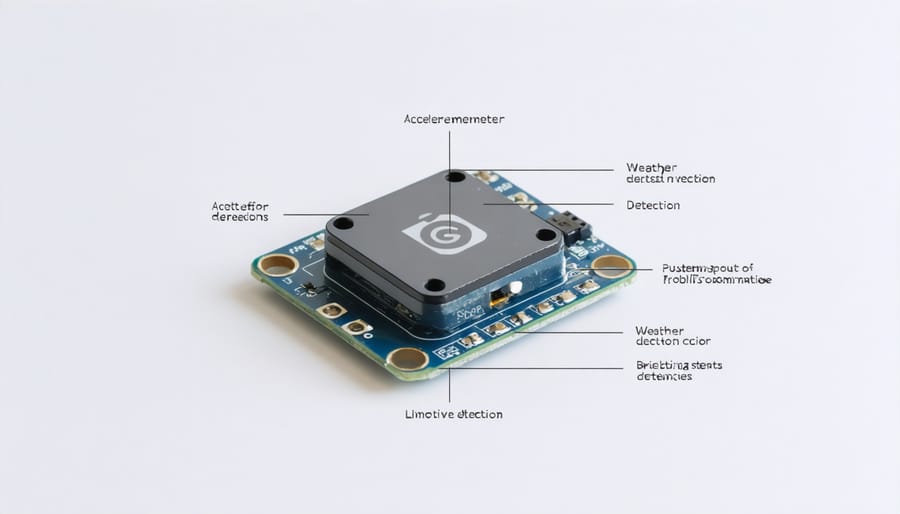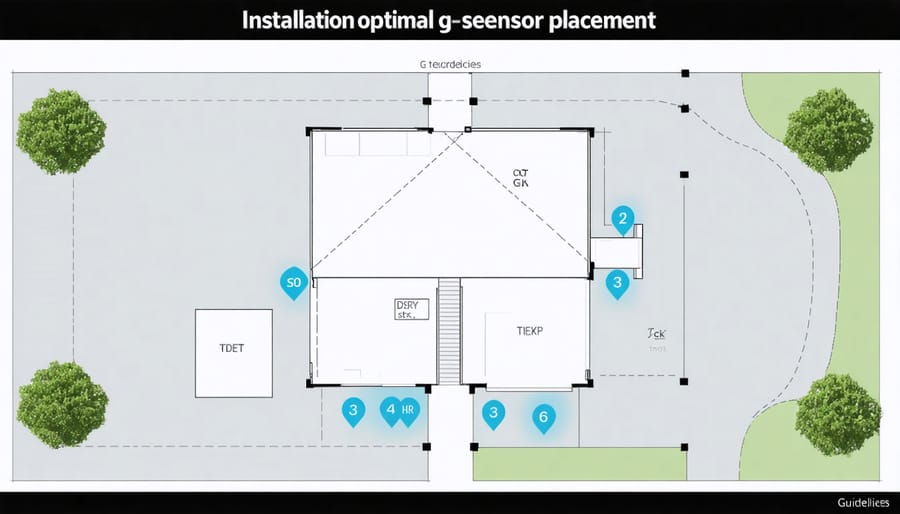G-sensors revolutionize modern weather-ready home automation by detecting subtle movements and changes in your environment. These clever devices measure gravitational forces and acceleration, acting as your home’s digital guardian against weather-related threats. Whether it’s triggering storm shutters during high winds or adjusting your smart thermostat based on environmental changes, g-sensors form the backbone of responsive home protection systems. As a crucial component in modern weather monitoring, these sensors translate complex physical movements into simple, actionable data that keeps your home safe and comfortable. Understanding how g-sensors work empowers homeowners to make informed decisions about their home security and automation needs, ensuring protection against unexpected weather events while maintaining optimal living conditions.
How G-Sensors Detect Weather Changes
The Science Behind G-Sensors
At the heart of every g-sensor is a clever piece of technology called an accelerometer. Think of it as a tiny weighted spring that can detect movement in different directions. When there’s movement, this spring shifts, and the sensor translates these movements into electrical signals that your weather monitoring system can understand.
These sensors work a bit like your inner ear, which helps you keep your balance. They can detect subtle changes in air pressure, wind speed, and even the tiniest vibrations that might signal approaching severe weather. The technology is so precise that it can pick up on changes well before you’d notice them yourself.
Modern g-sensors use something called MEMS technology (micro-electro-mechanical systems), which packs all this sensing power into a device smaller than a penny. They’re constantly measuring acceleration forces in three directions: up-down, left-right, and forward-backward. This 3D sensing ability helps create a complete picture of weather patterns and potential threats.
When combined with smart algorithms, these sensors can distinguish between regular environmental movements and concerning weather patterns, giving you reliable alerts when they matter most.

Weather Parameters G-Sensors Track
G-sensors in weather monitoring systems are remarkably versatile, tracking a wide range of environmental conditions that affect our daily lives. These smart devices can detect rainfall intensity by measuring the impact of raindrops, helping you know when it’s time to bring in the outdoor furniture or close the windows. They’re also excellent at monitoring wind speed and direction, which is particularly useful for protecting outdoor installations and knowing when to secure loose items around your property.
Temperature fluctuations are another key parameter these sensors track, but they go beyond just measuring degrees. They can detect rapid temperature changes that might signal approaching storms or severe weather conditions. Humidity levels are also monitored, helping you understand when conditions might affect your home’s structure or comfort level.
What makes these sensors particularly valuable is their ability to detect atmospheric pressure changes. This capability provides early warnings about incoming weather systems, giving you precious time to prepare your home for whatever Mother Nature has in store. Some advanced models can even track UV intensity and air quality, making them comprehensive weather monitoring solutions for your home.

Protecting Your Home with G-Sensor Systems
Automated Window and Door Response
When severe weather approaches, g-sensors in modern window and door systems act as your home’s first line of defense. These clever devices constantly monitor movement and vibration, ready to respond when conditions become threatening. Think of them as your home’s weather watchdogs, always on alert to protect your living space.
During high winds or storms, these sensors detect changes in pressure and movement that could potentially damage your windows and doors. Once triggered, they set several protective measures in motion. Your windows might automatically close and lock, while storm shutters can deploy without you lifting a finger. Some advanced systems even coordinate with your smart home setup to send alerts to your phone, letting you know your home is securing itself.
The sensitivity of these g-sensors can usually be adjusted to match your local weather patterns. If you live in an area prone to sudden storms, you might want a more responsive setting. For homes in milder climates, a less sensitive configuration might work better to avoid false alarms.
What makes these sensors particularly valuable is their ability to react faster than manual intervention. When every second counts during severe weather, having this automated response system can mean the difference between preventing damage and facing costly repairs.
Smart Awning and Shade Control
Modern awnings and shade systems have become increasingly sophisticated, incorporating g-sensors to protect your outdoor investments from unexpected weather conditions. These clever devices work alongside smart home climate control systems to automatically adjust your outdoor fixtures based on movement and vibration detection.
When strong winds pick up, g-sensors measure the force and acceleration acting on your awnings or shade sails. Once these measurements exceed preset safety thresholds, the system automatically retracts your awnings or adjusts shade positions to prevent damage. This smart response happens within seconds, protecting your outdoor fixtures even when you’re away from home.
The beauty of g-sensor technology lies in its simplicity and reliability. You won’t need to constantly monitor weather forecasts or rush home to secure your outdoor shading during unexpected storms. The sensors can detect subtle changes in wind patterns and respond accordingly, making them particularly valuable for protecting expensive motorized awnings and delicate shade structures.
For the best results, consider setting different sensitivity levels for different seasons. During storm-prone months, you might want to set lower thresholds for automatic retraction, while during calmer periods, you can allow for more movement before the system responds.
Setting Up Your G-Sensor Weather System
Choosing the Right Location
When installing your g-sensor, location is crucial for accurate readings and optimal performance. The ideal spot should be away from direct heat sources, such as HVAC vents or direct sunlight, which can interfere with measurements. Mount the sensor on a stable, vibration-free surface, preferably at chest height (around 4-5 feet from the ground) for easy access and maintenance.
For outdoor installations, choose a sheltered area that protects the sensor from rain and extreme weather while still allowing it to detect environmental changes. If you’re setting up a DIY weather monitoring setup, consider placing the g-sensor on a north-facing wall to minimize sun exposure.
Avoid corners or enclosed spaces where air circulation is limited. Instead, opt for open areas with good airflow. For indoor applications, central locations work best – think living rooms or hallways away from windows and exterior doors. Remember to keep the sensor at least 3 feet away from large metal objects, which can affect its performance.

Integration with Smart Home Systems
Integrating g-sensors with your existing smart home system is easier than you might think. Start by checking if your home automation hub (like SmartThings, Home Assistant, or Apple HomeKit) supports g-sensor connectivity. Most modern systems do, either directly or through third-party bridges.
To connect your g-sensor, first ensure it’s powered on and in pairing mode. Open your smart home app and navigate to “Add Device” or “Add Accessory.” Select “Sensor” from the device types and follow the on-screen instructions to complete the pairing process. Once connected, you can create custom automations based on g-sensor readings.
For example, you can set up alerts to notify you when unusual vibrations are detected, or program your system to automatically close smart blinds during high winds. Some advanced setups can even integrate with your home security system, triggering cameras or alarms when unexpected movement is detected.
Remember to place your g-sensor in a stable location and test your automations thoroughly before relying on them. Regular firmware updates will ensure your sensor maintains optimal performance and compatibility with your smart home system.
Maintenance Tips
To keep your g-sensor functioning properly, regular maintenance is essential. Start by gently cleaning the sensor surface with a soft, dry cloth every few months to remove any dust or debris that might affect its readings. Avoid using liquid cleaners or harsh chemicals, as these can damage the sensitive components.
Check the sensor’s mounting position periodically to ensure it hasn’t shifted from its optimal position. If you notice any loose screws or brackets, tighten them carefully without over-tightening, which could damage the housing.
For battery-operated g-sensors, replace the batteries according to the manufacturer’s recommendations, typically every 6-12 months. Keep spare batteries on hand to avoid any interruption in monitoring.
If you notice erratic readings or false alarms, first try recalibrating the sensor following your device’s manual. Sometimes, a simple reset can resolve common issues. For persistent problems, check all cable connections and ensure they’re securely fastened.
Remember to test your g-sensor monthly by simulating the conditions it’s designed to detect. This helps ensure it’s working correctly when you need it most.
The implementation of a g-sensor in your home’s weather response system is a smart investment that can significantly enhance your property’s safety and efficiency. By monitoring sudden changes in movement and orientation, these sensors provide an additional layer of protection for your home and family. They work seamlessly with other smart home devices, creating a comprehensive security network that responds instantly to potential threats or environmental changes.
Not only do g-sensors offer practical benefits like automatic storm shutters and garage door safety features, but they also provide peace of mind knowing your home is equipped with advanced protection technology. The relatively low cost of installation compared to the potential savings in preventing damage makes them an excellent choice for any homeowner looking to upgrade their home’s safety features.
Whether you’re tech-savvy or just starting to explore smart home solutions, g-sensors are user-friendly and require minimal maintenance once properly installed. Consider working with a qualified professional to ensure optimal placement and integration with your existing home systems. The investment in g-sensor technology today can protect your home for years to come, making it a worthwhile addition to any modern household’s safety arsenal.
Remember, the key to maximizing the benefits of g-sensors lies in proper setup and regular system checks. Take the time to understand your system’s features and capabilities, and you’ll be well-equipped to protect your home against various environmental challenges.
